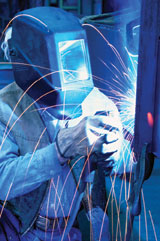Welding and Manganese Poisoning
 Exposure
to metal fumes from welding, cutting and brazingespecially in confined
spacescan cause brain damage. A major culprit is manganese, a component
of all steel and major welding materials. Manganese has been known
to cause the degenerative brain disorder known as Parkinsonism since
1837. A recent study found 40 percent of welders showed signs of
the disorder. Many physicians are unaware of manganese poisoning
or the risks of exposures in steel making and welding as stated
on Material Safety Data Sheets (MSDS).
Exposure
to metal fumes from welding, cutting and brazingespecially in confined
spacescan cause brain damage. A major culprit is manganese, a component
of all steel and major welding materials. Manganese has been known
to cause the degenerative brain disorder known as Parkinsonism since
1837. A recent study found 40 percent of welders showed signs of
the disorder. Many physicians are unaware of manganese poisoning
or the risks of exposures in steel making and welding as stated
on Material Safety Data Sheets (MSDS).
Symptoms of manganese poisoning include tremors, shakes, loss
of balance, slowed movement, walking problems, impotency, slurred
speech, extreme drowsiness or nighttime leg cramps. Because
the symptoms are similar, welders may be mistakenly diagnosed with
Parkinsons disease, ALS (Lou Gehrigs disease) or MS (multiple
sclerosis).
If you have any of these symptoms, go to your doctor as soon
as possible. Bring a copy of the MSDS for welding rods and other
related materials you commonly use.
If you do not have any of these symptoms:
- OSHA requires employers to use engineering controls such as
local exhaust ventilation to control health hazards. Personal
protective equipment like respirators may be necessary to supplement
other measures. Ask your employer to verify these air-monitoring
controls are suitably protective by showing exposures below the
threshold limit value for manganese (respirable fraction of 0.03
mg/m3). Ventilation, especially in enclosed work spaces, may not
be adequate. Powered air purifying respirators worn with a welding
hood are available.
- Obtain a copy of the MSDS for the welding rods you use. Ask
your union steward or occupational health provider to ensure your
supervisor is aware of manganese fumes and that measures are in
place to provide protection. Your employer has an obligation under
OSHA to show you a current MSDS for any product you work with.
- Consider welding only where effective exhaust ventilation is
in use. Supplement your protection with a National Institute for
Occupational Safety and Health-approved respirator. Employers
must provide respirators as part of a comprehensive respiratory
protection program.
Workers in the trades are often exposed to occupational health
risks. Tell your doctor about your job and request a personal health
risk evaluation.
